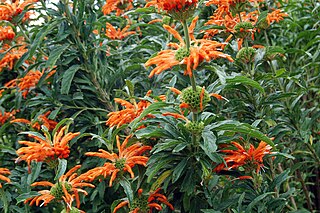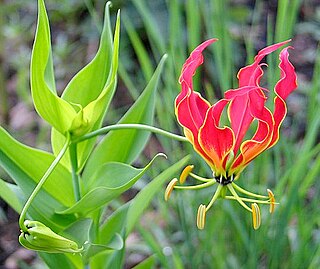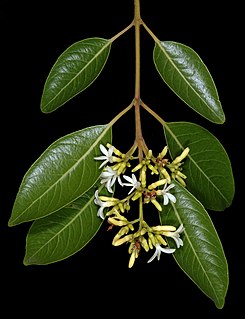
Bryonia is a genus of flowering plants in the gourd family. Bryony is its best-known common name. They are native to western Eurasia and adjacent regions, such as North Africa, the Canary Islands and South Asia.

Rosa multiflora is a species of rose known commonly as multiflora rose, baby rose, Japanese rose, many-flowered rose, seven-sisters rose, Eijitsu rose and rambler rose. It is native to eastern Asia, in China, Japan and Korea. It should not be confused with Rosa rugosa, which is also known as "Japanese rose", or with polyantha roses which are garden cultivars derived from hybrids of R. multiflora. It was introduced to North America, where it is regarded as an invasive species.

Elaeagnus multiflora, the cherry elaeagnus, cherry silverberry, goumi, gumi, or natsugumi, is a species of Elaeagnus native to China, Korea, and Japan.

Leonotis leonurus, also known as lion's tail and wild dagga, is a plant species in the mint family, Lamiaceae. The plant is a broadleaf evergreen large shrub native to South Africa and southern Africa, where it is very common. It is known for its medicinal properties. The main psychoactive component of Leonotis leonurus is claimed to be leonurine, Leonotis leonurus has been confirmed to contain Leonurine according to peer reviewed journal published phytochemical analysis. Like other plants in the mint family, it also contains marrubiin. The name 'wild dagga' links it closely to cannabis as 'dagga' derived from the Khoikhoi 'dachab' is an indigenous South African name for cannabis species. This name may be a misnomer, as no part of the plant is used as a hallucinogen.

Eucalyptus deglupta is a species of tall tree, commonly known as the rainbow eucalyptus, Mindanao gum, or rainbow gum that is native to the Philippines, Indonesia, and Papua New Guinea. It is the only Eucalyptus species that usually lives in rainforest, with a natural range that extends into the northern hemisphere. It is characterized by multi-colored bark.

Wachendorfia is a genus of perennial herbaceous plants that is assigned to the bloodroot family. The plants have a perennial rootstock with red sap. From the rootstock emerge lance- or line-shaped, sometime sickle-shaped, pleated, simple leaves set in a fan, that are flattened to create a left and right surface rather than an upper and lower surface. The leaves die when the seeds are shed in three of the species, and are perennial in one species. The rootstock also produces flowering stems annually that carry a panicle of zygomorphic, yellow or yellowish flowers in two distinct forms, one with the style and one stamen bent to the right and two stamens to the left, and vice versa. The fruit opens with three valves and each contains a single, hairy seed. All species only occur in the fynbos biome in the Cape provinces of South Africa.

Reynoutria multiflora is a species of flowering plant in the buckwheat family Polygonaceae native to central and southern China. It is known by the English common names tuber fleeceflower and Chinese (climbing) knotweed. It is known as he shou wu in China and East Asia. Another name for the species is fo-ti, which is a misnomer. The name he shou wu means 'the black-haired Mr. He'.

Senna alata is an important medicinal tree, as well as an ornamental flowering plant in the subfamily Caesalpinioideae. It also known as emperor's candlesticks, candle bush, candelabra bush, Christmas candles, empress candle plant, ringworm shrub, or candletree. A remarkable species of Senna, it was sometimes separated in its own genus, Herpetica.

Vernonia amygdalina, a member of the daisy family, is a small shrub that grows in tropical Africa. V. amygdalina typically grows to a height of 2–5 m (6.6–16.4 ft). The leaves are elliptical and up to 20 cm (7.9 in) long. Its bark is rough. V. amygdalina is commonly called Congo Bololo in D. R. Congo, bitter leaf in English because of its bitter taste. African common names include grawa (Amharic), ewuro (Yoruba), etidot (Efik), onugbu (Igbo), ityuna (Tiv), oriwo (Edo), Awɔnwono (Akan), chusar-doki or shuwaka (Hausa), mululuza (Luganda), labwori (Acholi), olusia (Luo), ndoleh (Cameroon) and olubirizi (Lusoga).

Mentzelia multiflora, commonly known as Adonis blazingstar, Adonis stickleaf, desert blazingstar, prairie stickleaf and manyflowered mentzelia is a herbaceous perennial wildflower of the family Loasaceae.

Gloriosa superba is a species of flowering plant in the family Colchicaceae. Common names include flame lily, climbing lily, creeping lily, glory lily, gloriosa lily, tiger claw, agnishikha and fire lily.

Strophanthus sarmentosus grows as either a deciduous shrub or as a liana up to 40 metres (130 ft) long, with a stem diameter up to 15 centimetres (6 in). Its fragrant flowers feature a white to purple corolla, red or purple-streaked on the inside. Strophanthus sarmentosus is native from west and central tropical Africa to Uganda and Angola. Vernacular names for the plant include spider tresses and poison arrow vine. Its habitat is forested areas from sea level to 1,400 metres (4,600 ft) altitude.
Hunteria zeylanica grows as either an evergreen shrub or as a tree up to 15 metres (49 ft) tall, with a trunk diameter of up to 34.5 centimetres (13.6 in). Its flowers feature a white corolla. The berries are yellow. Its habitat is forests from sea level to 350 metres (1,150 ft) altitude. The trees can withstand salinity. Local medicinal uses include for stomach-ache. Hunteria zeylanica wood is used for weapon handles and as firewood. In Africa, the plant is native to Kenya and Tanzania and in Asia it is native to China, India, Sri Lanka, Indochina and western Malesia.
Alafia multiflora is a plant in the family Apocynaceae.
Baissea is a genus of plant in the family Apocynaceae found in tropical Africa. As of August 2013 the World Checklist of Selected Plant Families recognises 18 species:
Baissea axillaris is a plant in the family Apocynaceae.

Diplorhynchus is a monotypic genus of plant in the family Apocynaceae native to tropical and southern Africa. As of August 2020, Plants of the World Online recognises the single species Diplorhynchus condylocarpon.
Oncinotis is a genus of plant in the family Apocynaceae, first described as a genus in 1849. It is native to Africa, including Madagascar. As of August 2013 the World Checklist of Selected Plant Families recognises 7 species:
- Oncinotis glabrata(Baill.) Stapf ex Hiern - tropical Africa from Liberia to Tanzania, south to Angola
- Oncinotis gracilisStapf - tropical Africa from Liberia to Central African Republic, south to Angola
- Oncinotis hirtaOliv. - C Africa from Cameroon to Angola
- Oncinotis nitidaBenth. - W Africa from Liberia to Republic of Congo
- Oncinotis pontyiDubard - tropical Africa from Guinea to Uganda
- Oncinotis tenuilobaStapf - C + S Africa from Nigeria east to Sudan + Ethiopia, south to Cape Province
- Oncinotis tomentellaRadlk. - Madagascar
- Oncinotis axillarisK.Schum. = Baissea multifloraA.DC.
- Oncinotis campanulataK.Schum = Baissea campanulata(K.Schum.) de Kruif
- Oncinotis melanocephalaK.Schum. = Baissea myrtifolia(Benth.) Pichon
- Oncinotis subsessilisK.Schum. = Baissea campanulata(K.Schum.) de Kruif
- Oncinotis zygodioidesK.Schum. = Baissea zygodioides(K.Schum.) Stapf

Pleiocarpa mutica is a plant in the family Apocynaceae.

Lippia abyssinica, or koseret, is a species of flowering plant in the verbena family, Verbenaceae. It is endemic to Ethiopia but cultivated throughout tropical African countries. The specific epithet abyssinica derives from Latin and means 'of or from Ethiopia (Abyssinia)'.














